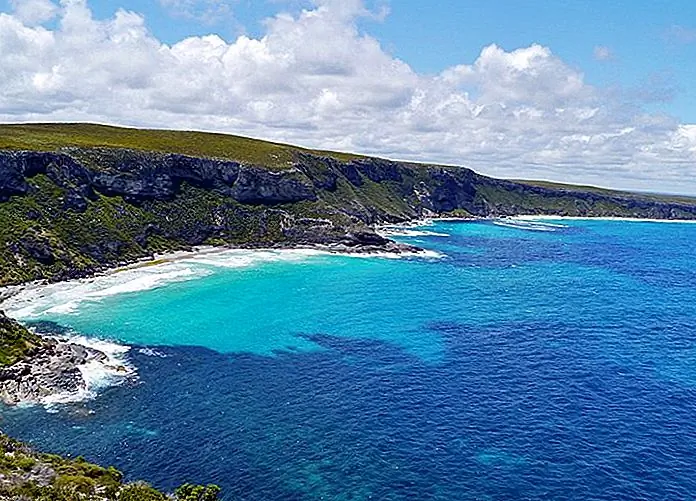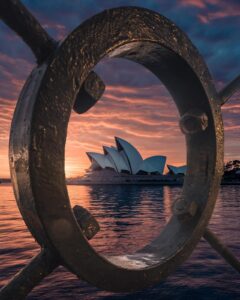South Australia’s vast wilderness, breathtaking coastline and stark desert beauty have captured the imagination of artists and adventurers for centuries. Capital Adelaide is on the cusp of all these natural wonders and offers a lively calendar of festivals and a relaxed friendliness. But the sparsely populated state has a wealth of other tourist treasures. Quaint rural villages with European charm, emerald green hills and cobalt crater lakes are among the best inland locations. Along the coast, visitors can sunbathe on beautiful beaches, picnic in secluded coves or interact with wildlife on Kangaroo Island, one of the country’s beloved tourist gems.
South Australia is also a foodie’s paradise. The state’s wild seas and picturesque pastoral country, fed by the mighty Murray River, produce an abundance of fresh produce – from citrus fruits and handmade cheeses to some of the country’s best seafood. Further afield, to the west and northwest, the arid wilderness meets the rose-hued peaks of the Flinders Ranges, the opal mines of Coober Pedy, vast deserts crossed by famous 4WD tracks and the legendary Nullarbor Plain.
Read also: top-rated tourist attractions in Adelaide
1 Kangaroo Island
Kangaroo Island of the Fleurieu Peninsula is the third largest island in Australia and one of the country’s best natural jewels. Sparkling cerulean seas, pristine beaches, rugged coastal scenery, fascinating rock formations, caves and close-up encounters with charismatic wildlife are the main attractions. In addition to the marsupial namesake, visitors can see koalas, seals, penguins, sea lions and a variety of birds in their natural habitat. Scuba divers often see dragons of the seas in the crystal clear temperate waters and many wrecks lie submerged in the shore.
In Flinders Chase National Park , the wind-sculpted boulders of the Remarkable Rocks and the eroded curve of Admiral’s Arch are striking geographical features. The island is also known for its abundance of fresh produce, including freshly shucked oysters, rock lobsters, free-range eggs and Ligurian honey. Tourists can fly directly to the island from Adelaide, or hop aboard a ferry from Cape Jervis on the Fleurieu Peninsula.
2 Adelaide

Adelaide, the capital of South Australia, is Australia’s fifth largest city and one of the most gracious. Parks and gardens punctuate the city and venerable 19th-century buildings stand proud among the burgeoning high-rises in the city center. Popular tourist attractions include the North Terrace Cultural District with its museums, galleries and carefully preserved historic gems; the Adelaide Central Market , a retail institution; and the impressive line-up of performances and events at the Adelaide Festival Centre . For a change of pace, tourists hop aboard the tram to Glenelgfrom Victoria Square to swim, sail and enjoy the seaside atmosphere, or venture into the beautiful scrub-clad hills of the Mount Lofty Ranges (Adelaide Hills).
3 Barossa Valley

The Barossa Valley, about an hour’s drive from Adelaide, is a favorite day trip from the capital. Blessed with fertile soils, this verdant valley is one of Australia’s oldest grape growing areas and a paradise for foodies lured by its high-quality fresh produce and artisan foods. German and English immigrants originally settled in the valley and their history and culture can still be felt in the historic buildings, heritage trails, museums and European cuisine. In addition to all the historical sights, the region offers plenty of other distractions. Visitors can shop at the popular farmers markets, take cooking classes, party at the fantastic restaurants, relax at the spas, and browse the many gift shops and art galleries.
4 Clare Valley

Along with the Barossa Valley , the Clare Valley is another venerable Australian wine-growing region and is located approximately 136 km north of Adelaide. Picturesque pastoral landscapes provide a perfect setting for romantic weekend getaways, and the region is known for its thriving gastronomic food scene. Polish, English and Irish immigrants originally settled in the valley and their culture and customs are still visible in the charming historic towns and historic bluestones. In the capital of Clare , named after County Clare in Ireland, visitors can explore the region’s history at the city’s museum, housed in a mid-19th century courthouse, or visit nearby Sevenhill, named for its rolling landscape reminiscent of the hills around Rome. From here, visitors can take the scenic drive to Polish Hills River Valley , explore the region’s history at the Polish Church Museum , or cycle the old railway line.
From 1845 to 1877, copper mining brought prosperity to the area around Burra , which has preserved its rich history in mine buildings, stone dwellings and museums along Burra’s Heritage Passport Trail. The English-style heritage town of Mintaro is home to Martindale Hall, a neoclassical mansion that is now a hotel. Popular things to do in the Clare Valley include exploring the beautiful Skilly Hills, dining in the excellent cafes and restaurants, and browsing the local markets, gift shops and art galleries. Every May, foodies gather here for the annual Clare Valley Gourmet Weekend , a celebration of the region’s abundant fresh produce.
Official site: https://www.clarevalley.com.au/
5 Flinders Ranges

Named after famous explorer Matthew Flinders, the Flinders Ranges are a delight for nature lovers, photographers and artists. In the changing light of the day, the arid landscapes provide a striking play of color – from pale pink and gold to burnt orange. Despite the dry conditions, the area is home to an astonishing abundance of wildlife (emus, yellow-footed cetaceans and flocks of brilliantly colored parrots in the region).
The mountains run north to south through the eastern part of South Australia extending 400 km north into the scorched Outback. In Flinders Ranges National Park , the region’s most scenic area, a rich growth of vegetation covers the sheltered valleys, and wildflowers carpet the parched earth in spring. Top attractions here include the natural amphitheater of Wilpena Pound with St Mary’s Peak at the highest point, Aboriginal art at Arkaroo Rock, fossils and part of the long-distance Heysen Trail named after the famous German-born Australian artist, Hans Heysen.
6 Fleurieu Peninsula

The scenic Fleurieu Peninsula, a south-westerly spur from the mountain Lofty Ranges, is a playground for many activities (fishing, boating, bush walking, whale watching, surfing and swimming – to name a few). The main tourist attractions are the beautiful scenery, nature reserves and beautiful beaches such as the sheltered sandy coves of Gulf St Vincent . Victor Harbor is one of the most popular beach resorts on the peninsula. Connected by a long causeway, Granite Island , protects it from the turbulent Southern Ocean and is a refuge for kangaroos and penguins.
On the narrow channel at the outlet of Lake Alexandrina , into which the Murray River flows, the fast-growing resort town of Goolwa was known in its heyday as the New Orleans of Australia because of the many paddle steamers that plied the river. Off Goolwa, Hindmarsh Island is a favorite spot for birdwatchers. Other popular stops on the peninsula include the surfing hotspot of Port Elliot and the vine-clad hills of McLaren Vale, an excellent wine-growing area. From Cape Jervis, at the tip of the peninsula, tourists can hop aboard a ferry to Kangaroo Island.
Official site: https://fleurieupeninsula.com.au/
7 Eyre Peninsula

Surrounded by a rugged and enchanting coastline of cliffs and sheltered beaches, the triangular Eyre Peninsula is one of Australia’s least crowded coastal areas and one of its most beautiful. It’s located east of the Great Australian Bight and cage diving with great white sharks scores top billing on the tourist adventure list. Visitors can also snorkel with giant squid near Whyalla , or swim with ballistic sea lions at Baird Bay . Whale watching is another popular activity from May to October, when southern right whales migrate along the Great Australian Bight Marine Park.
Coffin Bay is known for its excellent oysters and beautiful national park. Occupying the southern tip of the Eyre Peninsula, Lincoln National Park offers spectacular scenery with rugged cliffs and plenty of bird life, while Port Lincoln is an increasingly popular holiday resort. The fishing fleet, the largest in Australia, produces some of the country’s best seafood. Inland, visitors can explore the bushland and wildlife of the Gawler Ranges or head into the legendary Nullarbor Plain for a serious 4WD adventure through the scorched desert.
8 Murray River

Australia’s longest river, the mighty Murray, flows from its source in the New South Wales Alps to the Southern Ocean in South Australia. Sandstone cliffs and tall eucalyptus trees along the river and wetlands are important habitats for many waterfowl. Once home to the Ngarrindjeri and Nganguraku people, the river today irrigates a huge citrus industry and agricultural region and offers a wealth of water activities, from fishing, boating, water skiing and swimming to gliding on a paddle steamer.
Punctuated by colorful gardens and fragrant roses, the town on the River Renmark lies at the point where the states of South Australia, New South Wales and Victoria meet and is home to vast citrus plantations. From here, visitors can tour the Olivewood Historic Homestead and Museum , organize a river cruise, or rent a houseboat. Loxton is the ‘garden city’ of the Riverland region with galleries and historic sites. On the banks of the river, the historic village takes the visitor back in time with its faithfully recreated late 19th-century buildings and artifacts. The town of Waikerie is a popular spot for gliding and offers a lovely cliff top walk.
9 Mount Gambier

Along the Limestone Coast , Mount Gambier is an extinct volcano with four beautiful crater lakes as well as sinkholes and gardens. A strange natural phenomenon takes place on the Blue Lake annually in November, when the color of the lake changes from dull gray to a brilliant cobalt blue. A scenic drive with spectacular views runs around the crater. South of Mount Gambier, tourists can explore South Australia’s only World Heritage Site. Naracoorte Caves, with fascinating fossils, bat colonies and spooky subterranean landscapes. Other attractions on the Limestone coast include the bird-rich lagoons and coastal dunes of the Coorong, a chain of lagoons and salt lakes between Lake Alexandrina and the sea; the grape growing region of Coonawarra, beautiful Beachport, a former whaling station; and the historic seaside resort of Robe.
10 Coober Pedy

The opal mining town of Coober Pedy is located in the heart of the South Australian outback. The town’s name comes from an Aboriginal phrase meaning “white guys in a hole”, as most residents live in underground dwellings (dugouts) to escape the fierce heat of summer and the extreme cold of winter. In 1911, gold seekers found valuable white opals here. Over the years, the opal mines have turned the desolate landscape around Coober Pedy into a kind of moonscape. Visitors can still try their luck after obtaining a prospecting permit from the mining department in Coober Pedy. The Old Timers Mine and Museum displays exhibits on the history of gem mining. Tourists can also visit underground houses and undergroundCatacomb Church.
Read also:
Melbourne: a city that is both scenic and cosmopolitan





